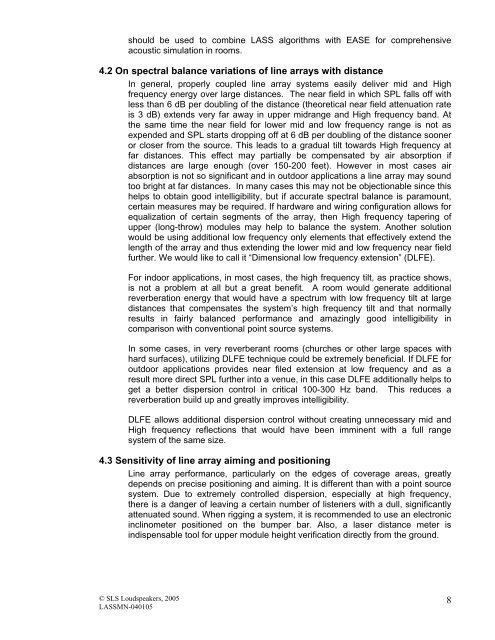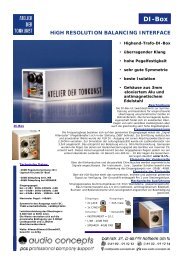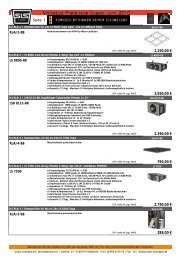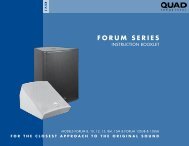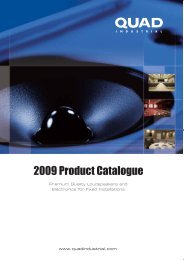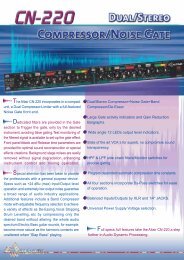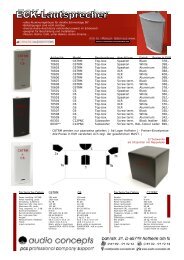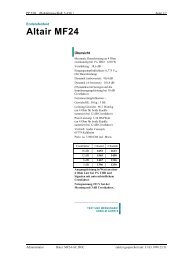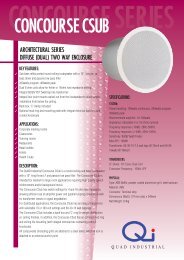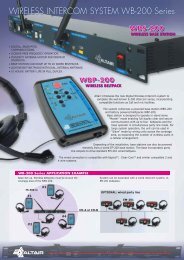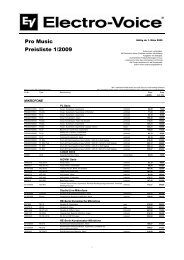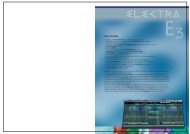LASS user manual - audio concepts
LASS user manual - audio concepts
LASS user manual - audio concepts
Create successful ePaper yourself
Turn your PDF publications into a flip-book with our unique Google optimized e-Paper software.
should be used to combine <strong>LASS</strong> algorithms with EASE for comprehensive<br />
acoustic simulation in rooms.<br />
4.2 On spectral balance variations of line arrays with distance<br />
In general, properly coupled line array systems easily deliver mid and High<br />
frequency energy over large distances. The near field in which SPL falls off with<br />
less than 6 dB per doubling of the distance (theoretical near field attenuation rate<br />
is 3 dB) extends very far away in upper midrange and High frequency band. At<br />
the same time the near field for lower mid and low frequency range is not as<br />
expended and SPL starts dropping off at 6 dB per doubling of the distance sooner<br />
or closer from the source. This leads to a gradual tilt towards High frequency at<br />
far distances. This effect may partially be compensated by air absorption if<br />
distances are large enough (over 150-200 feet). However in most cases air<br />
absorption is not so significant and in outdoor applications a line array may sound<br />
too bright at far distances. In many cases this may not be objectionable since this<br />
helps to obtain good intelligibility, but if accurate spectral balance is paramount,<br />
certain measures may be required. If hardware and wiring configuration allows for<br />
equalization of certain segments of the array, then High frequency tapering of<br />
upper (long-throw) modules may help to balance the system. Another solution<br />
would be using additional low frequency only elements that effectively extend the<br />
length of the array and thus extending the lower mid and low frequency near field<br />
further. We would like to call it “Dimensional low frequency extension” (DLFE).<br />
For indoor applications, in most cases, the high frequency tilt, as practice shows,<br />
is not a problem at all but a great benefit. A room would generate additional<br />
reverberation energy that would have a spectrum with low frequency tilt at large<br />
distances that compensates the system’s high frequency tilt and that normally<br />
results in fairly balanced performance and amazingly good intelligibility in<br />
comparison with conventional point source systems.<br />
In some cases, in very reverberant rooms (churches or other large spaces with<br />
hard surfaces), utilizing DLFE technique could be extremely beneficial. If DLFE for<br />
outdoor applications provides near filed extension at low frequency and as a<br />
result more direct SPL further into a venue, in this case DLFE additionally helps to<br />
get a better dispersion control in critical 100-300 Hz band. This reduces a<br />
reverberation build up and greatly improves intelligibility.<br />
DLFE allows additional dispersion control without creating unnecessary mid and<br />
High frequency reflections that would have been imminent with a full range<br />
system of the same size.<br />
4.3 Sensitivity of line array aiming and positioning<br />
Line array performance, particularly on the edges of coverage areas, greatly<br />
depends on precise positioning and aiming. It is different than with a point source<br />
system. Due to extremely controlled dispersion, especially at high frequency,<br />
there is a danger of leaving a certain number of listeners with a dull, significantly<br />
attenuated sound. When rigging a system, it is recommended to use an electronic<br />
inclinometer positioned on the bumper bar. Also, a laser distance meter is<br />
indispensable tool for upper module height verification directly from the ground.<br />
© SLS Loudspeakers, 2005<br />
<strong>LASS</strong>MN-040105<br />
8


